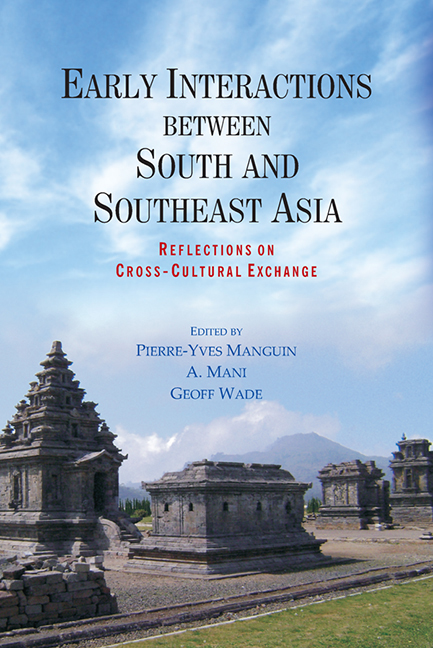Book contents
- Frontmatter
- Contents
- FOREWORD
- Preface
- Introduction
- PART I New Archaeological Evidence from South Asia and Southeast Asia
- 1 Central Vietnam during the Period from 500 BCE to CE 500
- 2 Ban Don Ta Phet and Khao Sam Kaeo: The Earliest Indian Contacts Re-assessed
- 3 Preliminary Study of Indian and Indian Style Wares from Khao Sam Kaeo (Chumphon, Peninsular Thailand), Fourth-Second Centuries BCE
- 4 Early Contacts between India and the Andaman Coast in Thailand from the Second Century BCE to Eleventh Century CE
- 5 The Batujaya Site: New Evidence of Early Indian Infl uence in West Java
- 6 Continuity and Change in South Indian Involvement in Northern Sumatra: The Inferences of Archaeological Evidence from Kota Cina and Lamreh
- 7 South Asia and the Tapanuli Area (North-West Sumatra): Ninth-Fourteenth Centuries CE
- 8 Emergence of Early Historic Trade in Peninsular India
- 9 Contacts between India and Southeast Asia in Ceramic and Boat Building Traditions
- 10 Marine Archaeological Investigations along the Tamil Nadu Coast and their Implications for Understanding Cultural Expansion to Southeast Asian Countries
- PART II Localisation in Southeast Asia
- LIST OF CONTRIBUTORS
- INDEX
4 - Early Contacts between India and the Andaman Coast in Thailand from the Second Century BCE to Eleventh Century CE
from PART I - New Archaeological Evidence from South Asia and Southeast Asia
Published online by Cambridge University Press: 21 October 2015
- Frontmatter
- Contents
- FOREWORD
- Preface
- Introduction
- PART I New Archaeological Evidence from South Asia and Southeast Asia
- 1 Central Vietnam during the Period from 500 BCE to CE 500
- 2 Ban Don Ta Phet and Khao Sam Kaeo: The Earliest Indian Contacts Re-assessed
- 3 Preliminary Study of Indian and Indian Style Wares from Khao Sam Kaeo (Chumphon, Peninsular Thailand), Fourth-Second Centuries BCE
- 4 Early Contacts between India and the Andaman Coast in Thailand from the Second Century BCE to Eleventh Century CE
- 5 The Batujaya Site: New Evidence of Early Indian Infl uence in West Java
- 6 Continuity and Change in South Indian Involvement in Northern Sumatra: The Inferences of Archaeological Evidence from Kota Cina and Lamreh
- 7 South Asia and the Tapanuli Area (North-West Sumatra): Ninth-Fourteenth Centuries CE
- 8 Emergence of Early Historic Trade in Peninsular India
- 9 Contacts between India and Southeast Asia in Ceramic and Boat Building Traditions
- 10 Marine Archaeological Investigations along the Tamil Nadu Coast and their Implications for Understanding Cultural Expansion to Southeast Asian Countries
- PART II Localisation in Southeast Asia
- LIST OF CONTRIBUTORS
- INDEX
Summary
The Andaman Coast of the southern region of Thailand displays numerous evidences that reveal the long history of trade and cultural contacts between Thailand and other countries. By the early part of the Common Era these trade routes reached out to bring together the previously rather disparate Southeast Asian exchange systems, linking them into a vast network stretching from Western Europe, via the Mediterranean Basin, the Persian Gulf and the Red Sea, to India, Southeast Asia and China. This period saw the first appearance of what has been called the World System (Glover 1996: 59). The contacts caused the communities located along the Andaman Coast to rapidly become a significant trading-station in Southeast Asia (Fig. 4.1).
EARLY SEAPORTS ON THE ANDAMAN COAST
The southern region of Thailand is geographically part of the Thai-Malay Peninsula, forming a natural wall stretching into the sea. The area became a meeting point for the ships sailing between the east and the west. This led to the establishment of the early trading-stations on the Andaman Coast. During the uncomfortable journey along the coastline, resting points were essential for tired sailors and crews. Consequently, commercial connections fostered cultural exchange and engendered settlements of foreign sailors and traders, especially Indian people, during early times. The foreigners gradually merged with the local people. Later on Indian merchants established trading-stations at many ports in Southeast Asia. In ancient Indian literature, the area was called Suwannaphumi (Swarnabhumi). The trading stations founded by Indians did not distribute only Indian goods, but also Roman products and items that imitated the original Roman goods. The Roman items came to Southeast Asia because at that time the Romans had already founded many trading stations in India (Phasook Indrawooth 2005: 37). The archaeological site Khuan Luk Pat at Khlong Thom, Krabi Province, is located on the coast of the Andaman Sea. There is archaeological evidence that illustrates the contacts with overseas regions since the beginning of the Common Era. The number of beads found at this site is ample enough to say that this place was once significant bead-making site in Thailand.
- Type
- Chapter
- Information
- Early Interactions between South and Southeast AsiaReflections on Cross-Cultural Exchange, pp. 83 - 112Publisher: ISEAS–Yusof Ishak InstitutePrint publication year: 2011



